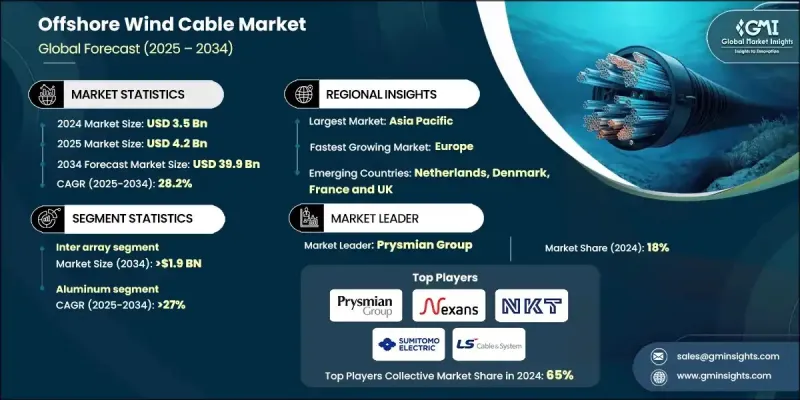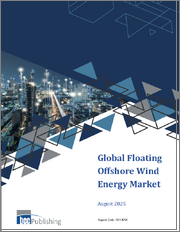
|
시장보고서
상품코드
1844329
해상 풍력 케이블 시장 기회, 성장 촉진요인, 산업 동향 분석, 예측(2025-2034년)Offshore Wind Cable Market Opportunity, Growth Drivers, Industry Trend Analysis, and Forecast 2025 - 2034 |
||||||
세계의 해상 풍력 케이블 시장은 2024년에는 35억 달러에 달하며, CAGR 28.2%로 성장하며, 2034년에는 399억 달러에 달할 것으로 추정되고 있습니다.

성장의 원동력은 케이블 제조 및 설치 기술의 급속한 발전으로 인한 운영 비용의 지속적인 하락으로 대규모 해상 풍력발전 프로젝트를 보다 경제적으로 실현 가능하게 만들고 있습니다. 협력 관계와 진화하는 물류 프레임워크는 케이블에 대한 접근성을 개선하고 시장 역학을 더욱 강화하고 있습니다. 환경 규제가 강화됨에 따라 지속가능하고 환경 친화적인 해저 케이블 솔루션 설계를 추진하려는 움직임이 강화되고 있습니다. 업계 리더들은 환경 파괴를 최소화하기 위해 케이블의 재활용 및 재사용을 채택하고 있습니다. 전체 생산 및 배치 방법의 표준화는 일관성과 성능을 향상시키고, 비용 관리 및 장기적인 신뢰성 향상으로 이어집니다. 재생에너지 개발에 대한 정부의 우대정책과 재정적 지원은 해상풍력 인프라 구축을 더욱 가속화하고 있습니다. 해상 풍력발전소 설치가 증가함에 따라 해상에서 생산된 전력을 육상 송전망에 안정적으로 전송하기 위한 견고한 해저 연결이 필요하며, 광범위한 에너지 전망에서 풍력 케이블의 전략적 중요성이 증가하고 있습니다. 제조업체들이 탄력성과 확장성을 추구하는 가운데, 해상풍력 케이블 산업은 전 세계에서 전례 없는 투자와 확장을 목격하고 있습니다.
| 시장 범위 | |
|---|---|
| 시작연도 | 2024 |
| 예측연도 | 2025-2034 |
| 시장 규모 | 35억 달러 |
| 예측 금액 | 399억 달러 |
| CAGR | 28.2% |
어레이 간 케이블 분야는 대용량 재생에너지 시설의 설치 증가와 심해 개발을 위한 엔지니어링 기술 발전에 힘입어 2034년 19억 달러에 달할 것으로 예측됩니다. 각 제조업체들은 유지보수 및 운영 중단을 최소화하는 데 주력하는 한편, 설치 비용 절감에도 힘쓰고 있습니다. 송전 손실 감소, 프로젝트 실행 비용 절감 등 유리한 특성으로 인해 어레이 간 케이블은 오프쇼어 사업자에게 선호되는 선택이 되고 있습니다.
구리 분야는 2034년 375억 달러에 달할 것입니다. 구리의 높은 내구성, 뛰어난 전기 전도성, 해저 조건에서의 내식성이 해양 설비에서 구리의 보급을 촉진하고 있습니다. 서지 부하와 가혹한 환경에도 견딜 수 있으며, 고전압 어레이 간 시스템에 이상적입니다. 66kV 어레이 간 시스템의 통합이 진행되고 있으며, 이는 주로 구리 기반이기 때문에 향후 10년간 부문 성장을 더욱 촉진할 것으로 예측됩니다.
미국 해상풍력 케이블 2024년 시장 규모는 5억 1,000만 달러에 달했습니다. 미국은 대규모 재생에너지에 대한 관심이 높아지고 있고, 오프쇼어 구역에 대한 기술력이 뛰어나기 때문에 미국은 주요 기업으로 자리매김하고 있습니다. 풍력 케이블 시스템과 함께 번들 서비스를 제공하려는 수요와 엔지니어링 전문 지식을 확대하려는 노력은 북미 시장의 향후 모멘텀을 지원하고 있습니다.
해상풍력 케이블 산업을 선도하는 주요 기업으로는 Sumitomo Electric Industries, ZTT, KEI Industries, C.S. Cable Corp., Seaway7, NKT A/S, Cavicel, LEONI, Hydro Group, Nexans, Prysmian Group, KEC International, Furukawa Electric, Fujikura Ltd., JDR Cable Systems, Hellenic Cables, Ningbo Orient Wires & Cables, Orient Cable, Hengtong Group, LS Cable & System. 등이 있습니다. 이들 기업은 제조 역량을 적극적으로 확장하고 신흥 풍력 시장 전반에서 세계 입지를 강화하고 있습니다. 해상풍력 케이블 시장의 주요 기업은 지역 제조 허브를 설립하고 장기 공급 계약을 확보함으로써 세계 사업을 적극적으로 확장하고 있습니다. 신뢰성과 성능을 향상시키기 위해 각 회사는 가혹한 해저 조건에서도 사용할 수 있는 고압 케이블 시스템을 개발하기 위해 연구개발에 투자하고 있습니다. 또한 재활용 가능한 소재와 친환경 케이블 설계에 중점을 두는 등 지속가능성에도 중점을 두고 있습니다. 전략적 제휴와 합병을 통해 첨단 기술에 대한 접근이 가능해졌고, 개발 리스크도 줄었습니다.
목차
제1장 조사 방법과 범위
제2장 개요
제3장 업계 인사이트
- 업계 에코시스템
- 규제 상황
- 업계에 대한 영향요인
- 촉진요인
- 업계의 잠재적 리스크 & 과제
- 성장 가능성 분석
- 주요 해상 풍력발전 프로젝트
- 운영
- 제안
- 가격 동향 분석, 2021-2034
- 도체 재료별
- 지역별
- Porter의 산업 분석
- 공급 기업의 교섭력
- 바이어의 교섭력
- 신규 진출업체의 위협
- 대체품의 위협
- PESTEL 분석
제4장 경쟁 구도
- 서론
- 기업의 시장 점유율 분석 : 지역별
- 북미
- 유럽
- 아시아태평양
- 전략적 대시보드
- 전략적 구상
- 기업 벤치마킹
- 혁신과 테크놀러지의 상황
제5장 시장 규모·예측 : 최종 용도별, 2021-2034
- 주요 동향
- 어레이간
- 11kV-33kV
- 34kV-66kV
- 수출
- 132kV 이하
- 132kV 이상
제6장 시장 규모·예측 : 도체 재질별, 2021-2034
- 주요 동향
- 알루미늄
- 구리
제7장 시장 규모·예측 : 지역별, 2021-2034
- 주요 동향
- 북미
- 미국
- 캐나다
- 유럽
- 영국
- 독일
- 덴마크
- 프랑스
- 네덜란드
- 벨기에
- 아시아태평양
- 중국
- 일본
- 한국
- 베트남
- 대만
- 세계의 기타 지역
제8장 기업 개요
- Cavicel
- C.S. Cable Corp.
- Furukawa Electric
- Fujikura Ltd.
- Hellenic Cables
- Hengtong Group
- Hydro Group
- JDR Cable Systems
- KEI Industries
- KEC International
- LS Cable &System
- LEONI
- Prysmian Group
- Orient Cable
- NEXANS
- NKT A/S
- Ningbo Orient Wires &Cables
- Seaway7
- Sumitomo Electric Industries
- ZTT
The Global Offshore Wind Cable Market was valued at USD 3.5 billion in 2024 and is estimated to grow at a CAGR of 28.2% to reach USD 39.9 billion by 2034.

The growth is driven by rapid advancements in cable manufacturing and installation technologies that continue to lower operational costs, making large-scale offshore wind projects more financially feasible. Collaborations and evolving logistics frameworks are improving cable accessibility, further strengthening market dynamics. As environmental regulations tighten, there is a growing push to design sustainable and eco-conscious submarine cable solutions. Industry leaders are also adopting cable recycling and reuse practices to minimize environmental disruption. Standardization across production and deployment methods is enhancing consistency and performance, leading to better cost control and long-term reliability. Government incentives and financial support for renewable energy development are further accelerating the deployment of offshore wind infrastructure. The rise in offshore wind farm installations demands robust subsea connectivity to ensure reliable transmission of electricity generated offshore to land-based grids, reinforcing the strategic importance of wind cables in the broader energy landscape. As manufacturers aim for resilience and scalability, the offshore wind cable industry is witnessing unprecedented investment and expansion globally.
| Market Scope | |
|---|---|
| Start Year | 2024 |
| Forecast Year | 2025-2034 |
| Start Value | $3.5 Billion |
| Forecast Value | $39.9 Billion |
| CAGR | 28.2% |
The inter-array cable segment is projected to reach USD 1.9 billion by 2034, fueled by the increasing installation of high-capacity renewable energy facilities and advancements in engineering technologies for deep-water developments. Manufacturers are focusing on minimizing maintenance and operational disruptions, while also driving down installation expenses. Favorable attributes such as lower transmission losses and reduced project execution costs make inter-array cables a preferred choice for offshore operators.
The copper segment will reach USD 37.5 billion by 2034. Copper's high durability, exceptional conductivity, and resistance to corrosion under seabed conditions continue to drive its widespread usage in offshore installations. It withstands surge loads and harsh environments, making it ideal for high-voltage inter-array systems. Growing integration of 66kV inter-array systems, which are primarily copper-based, is further expected to support segment growth in the coming decade.
U.S. Offshore Wind Cable Market was valued at USD 510 million in 2024. The rise of large-scale renewable energy efforts combined with significant technical capacity across offshore zones has positioned the U.S. as a key player. The demand for bundled service offerings along with wind cable systems and efforts to scale up engineering expertise is helping shape North America market momentum going forward.
Key players driving the Offshore Wind Cable Industry include Sumitomo Electric Industries, ZTT, KEI Industries, C.S. Cable Corp., Seaway7, NKT A/S, Cavicel, LEONI, Hydro Group, Nexans, Prysmian Group, KEC International, Furukawa Electric, Fujikura Ltd., JDR Cable Systems, Hellenic Cables, Ningbo Orient Wires & Cables, Orient Cable, Hengtong Group, and LS Cable & System. These companies are actively expanding their manufacturing capacity and reinforcing their global presence across emerging wind markets. Leading companies in the Offshore Wind Cable Market are aggressively scaling their global operations by establishing regional manufacturing hubs and securing long-term supply contracts. To improve reliability and performance, firms are investing in R&D to develop high-voltage cable systems capable of operating under harsh seabed conditions. Sustainability is also central, with increased focus on recyclable materials and eco-friendly cable designs. Strategic alliances and mergers are enabling access to advanced technologies and reducing development risk.
Table of Contents
Chapter 1 Methodology & Scope
- 1.1 Research design
- 1.1.1 Research approach
- 1.1.2 Data collection methods
- 1.1.3 Base estimates and calculations
- 1.1.4 Base year calculation
- 1.1.5 Key trends for market estimates
- 1.2 Forecast model
- 1.3 Primary research & validation
- 1.3.1 Primary sources
- 1.4 Data mining sources
- 1.5 Market definitions
Chapter 2 Executive Summary
- 2.1 Industry 3600 synopsis, 2021 - 2034
- 2.2 Business trends
- 2.3 End use trends
- 2.4 Application trends
- 2.5 Regional trends
Chapter 3 Industry Insights
- 3.1 Industry ecosystem
- 3.2 Regulatory landscape
- 3.3 Industry impact forces
- 3.3.1 Growth drivers
- 3.3.2 Industry pitfalls & challenges
- 3.4 Growth potential analysis
- 3.5 Major offshore wind projects
- 3.5.1 Operational
- 3.5.2 Proposed
- 3.6 Price trend analysis, 2021-2034
- 3.6.1 By conductor material
- 3.6.2 By region
- 3.7 Porter's analysis
- 3.7.1 Bargaining power of suppliers
- 3.7.2 Bargaining power of buyers
- 3.7.3 Threat of new entrants
- 3.7.4 Threat of substitutes
- 3.8 PESTEL analysis
Chapter 4 Competitive landscape, 2025
- 4.1 Introduction
- 4.2 Company market share analysis, by region, 2024
- 4.2.1 North America
- 4.2.2 Europe
- 4.2.3 Asia Pacific
- 4.3 Strategic dashboard
- 4.4 Strategic initiatives
- 4.5 Company benchmarking
- 4.6 Innovation & technology landscape
Chapter 5 Market Size and Forecast, By End Use, 2021 - 2034 (USD Million & Km)
- 5.1 Key trends
- 5.2 Inter-array
- 5.2.1 11kV-33kV
- 5.2.2 34kV-66kV
- 5.3 Export
- 5.3.1 132 kV & Less
- 5.3.2 132 kV & above
Chapter 6 Market Size and Forecast, By Conductor Material, 2021 - 2034 (USD Million & Km)
- 6.1 Key trends
- 6.2 Aluminum
- 6.3 Copper
Chapter 7 Market Size and Forecast, By Region, 2021 - 2034 (USD Million & Km)
- 7.1 Key trends
- 7.2 North America
- 7.2.1 U.S.
- 7.2.2 Canada
- 7.3 Europe
- 7.3.1 UK
- 7.3.2 Germany
- 7.3.3 Denmark
- 7.3.4 France
- 7.3.5 Netherlands
- 7.3.6 Belgium
- 7.4 Asia Pacific
- 7.4.1 China
- 7.4.2 Japan
- 7.4.3 South Korea
- 7.4.4 Vietnam
- 7.4.5 Taiwan
- 7.5 Rest of World
Chapter 8 Company Profiles
- 8.1 Cavicel
- 8.2 C.S. Cable Corp.
- 8.3 Furukawa Electric
- 8.4 Fujikura Ltd.
- 8.5 Hellenic Cables
- 8.6 Hengtong Group
- 8.7 Hydro Group
- 8.8 JDR Cable Systems
- 8.9 KEI Industries
- 8.10 KEC International
- 8.11 LS Cable & System
- 8.12 LEONI
- 8.13 Prysmian Group
- 8.14 Orient Cable
- 8.15 NEXANS
- 8.16 NKT A/S
- 8.17 Ningbo Orient Wires & Cables
- 8.18 Seaway7
- 8.19 Sumitomo Electric Industries
- 8.20 ZTT



















